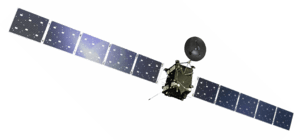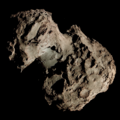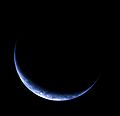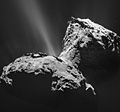Rosetta (spacecraft) facts for kids

Artist's illustration of Rosetta
|
|
| Mission type | Comet orbiter/lander |
|---|---|
| Operator | ESA |
| Mission duration | Final: 12 years, 6 months, 28 days |
| Spacecraft properties | |
| Manufacturer | Astrium |
| Launch mass | Orbiter: 2,900 kg (6,400 lb) Lander: 100 kg (220 lb) |
| Dry mass | Orbiter: 1,230 kg (2,710 lb) |
| Payload mass | Orbiter: 165 kg (364 lb) Lander: 27 kg (60 lb) |
| Dimensions | 2.8 × 2.1 × 2 m (9.2 × 6.9 × 6.6 ft) |
| Power | 850 watts at 3.4 AU |
| Start of mission | |
| Launch date | 2 March 2004, 07:17:51 UTC |
| Rocket | Ariane 5G+ V-158 |
| Launch site | Kourou ELA-3 |
| Contractor | Arianespace |
| End of mission | |
| Disposal | Deorbited |
| Last contact | 30 September 2016, 10:39:28 UTC SCET |
| Landing site | Sais, Ma'at region 2 years, 55 days of operations at the comet |
| Flyby of Mars | |
| Closest approach | 25 February 2007 |
| Distance | 250 km (160 mi) |
| Flyby of 2867 Šteins | |
| Closest approach | 5 September 2008 |
| Distance | 800 km (500 mi) |
| Flyby of 21 Lutetia | |
| Closest approach | 10 July 2010 |
| Distance | 3,162 km (1,965 mi) |
| 67P/Churyumov–Gerasimenko orbiter | |
| Orbital insertion | 6 August 2014, 09:06 UTC |
| Orbit parameters | |
| Periapsis | 29 km (18 mi) |
|
|
|
The Rosetta mission was a space project by the ESA. Its main goal was to study a comet called 67P/Churyumov–Gerasimenko. The mission had two main parts: the Rosetta spacecraft, which orbited the comet, and the Philae lander, which tried to land on it.
Rosetta was launched into space on March 2, 2004, using an Ariane 5 rocket. After a long journey, Philae landed on the comet on November 12, 2014. However, it soon lost power and stopped communicating. Rosetta kept orbiting and studying the comet until September 30, 2016, when it also landed on the comet, ending its mission.
Contents
What Was the Rosetta Mission?
The Rosetta mission was designed to learn more about comets. Comets are like icy space rocks that travel around the Sun. Scientists believe they hold clues about how our solar system formed. Rosetta was the first mission ever to orbit a comet and send a lander to its surface.
Why Study Comets?
Studying comets helps scientists understand the early days of our solar system. Comets are like time capsules because they are made of material from when the solar system was very young. By studying them, we can learn about the ingredients that made up Earth and other planets.
The Journey to Comet 67P
Rosetta had a very long and complex journey to reach Comet 67P/Churyumov–Gerasimenko. It traveled for over 10 years and covered billions of kilometers.
Gravity Assists: How Rosetta Got There
To save fuel and gain speed, Rosetta used a clever trick called "gravity assists." This means it flew close to planets like Earth and Mars. Their gravity pulled Rosetta and gave it a boost, like a slingshot.
- Rosetta flew past Mars on February 25, 2007.
- It also flew past two asteroids: 2867 Šteins in September 2008 and 21 Lutetia in July 2010. These flybys allowed Rosetta to take pictures and gather data from these space rocks too.
Arriving at the Comet
After its long journey, Rosetta finally reached Comet 67P on August 6, 2014. It then began to orbit the comet, getting closer and closer to prepare for the lander.
The Philae Lander
The Philae lander was a small robot carried by Rosetta. Its job was to land on the comet's surface and study it up close.
Philae's Landing
On November 12, 2014, Philae separated from Rosetta and began its descent to the comet. It was a very difficult landing because the comet's gravity is very weak. Philae bounced a few times before settling in a shady spot.
Challenges on the Comet
Because Philae landed in a shady area, its solar panels didn't get enough sunlight to charge its batteries. It managed to send back some data for a few days but then went silent. Later, it briefly woke up as the comet got closer to the Sun, but contact was lost again.
Rosetta's Orbit and Discoveries
Even after Philae went silent, Rosetta continued its important work. It orbited Comet 67P for over two years, studying it in detail.
What Rosetta Discovered
Rosetta sent back amazing pictures and information about the comet. It helped scientists learn about the comet's shape, how it changes as it gets closer to the Sun, and what it's made of. For example, Rosetta found that the comet's water is different from Earth's water. This suggests that most of Earth's water might not have come from comets like 67P.
The End of the Mission
On September 30, 2016, the Rosetta mission came to an end. To get even more close-up data, Rosetta was guided to slowly descend and land on the comet itself. This was a planned "controlled crash" that allowed it to send back its final, very close images and data before losing contact forever.
Images for kids
-
Rosetta's signal received at ESOC in Darmstadt, Germany, on 20 January 2014
-
Cartoon versions of Rosetta and Philae as they appear in the ESA's Once upon a time... series.
See also
 In Spanish: Rosetta (sonda espacial) para niños
In Spanish: Rosetta (sonda espacial) para niños












